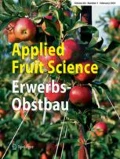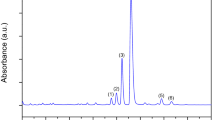Abstract
In this study, trans-resveratrol (t-RSV; 3,5,4′-trihydroxy-trans-stilbene) contents of the ripened berries of 23 clones of ‘Kalecik Karası’ which is one of Turkey’s leading red wine grape cultivars, grown in Ankara (Kalecik) were determined by HPLC. For this purpose; the berries were collected at 22–24 °Brix during 2016–2017 vintage seasons. Descriptive statistics for t-RSV content of clones were expressed as mean with their standard errors. One-way analysis of variance was performed for the comparison. Duncan multiple comparison test was used to determine the significant variances among clones. In addition, Analysis of Mean (ANOM) was also applied to determine the differences of the clones from the grand mean. As a result, t-RSV content of the clones ranged from 0.31 mg kg−1 (Clone 22) to 1.67 mg kg−1 (Clone 7) followed by Clone 6 with 1.12 mg kg−1 and differences among the clones were statistically significant (p < 0.05).

Similar content being viewed by others
References
Adrian M, Jeandet P, Douillet-Breuil AC, Tesson L, Bessis R (2000) Stilbene content of mature Vitis vinifera berries in response to UV‑C elicitation. J Agric Food Chem 48:6103–6105
Amerine MA, Cruess MV (1960) The technology of wine making. Avi Publishing, Westport
Anli RE, Vural N (2009) Antioxidant phenolic substances of Turkish red wines from different wine regions. Molecules 14:289–297
Bavaresco L, Fregoni C (2001) Physiological role and molecular aspects of grapevine stilbenic compounds. In: Roubelakis-Angelakis KA (ed) Molecular biology and biotechnology of the grapevine. Kluwer, Netherlands, pp 153–182
Bavaresco L, Cantu E, Fregoni M, Trevisan M (1997a) Constitutive stilben contents of grapevine cluster stems as potential source of resveratrol in wine. Vitis 36:115–118
Bavaresco L, Petegolli D, Cantu E, Fregoni C, Chiusa G, Trevisan M (1997b) Elicitation and accumulation of stilbene phytoalexins in grapevine berries infected by Botrytis cinerea. Vitis 36(2):77–83
Bavaresco L, Civardi S, Pezzutto S, Vezzulli S, Ferrari F (2005) Grape production, technological parameters, and stilbenic compounds as affected by lime-induced chlorosis. Vitis 44(2):63–65
Bavaresco L, Gatti M, Pezzutto S, Fregoni M, Mattivi F (2008) Effect of leaf removal on grape yield, berry composition, and stilbene concentration. Am J Enol Vitic 59:292–298
Bavaresco L, Pezzutto S, Gatti M, Mattivi F (2007) Role of the variety and some environmental factors on grape stilbenes. Vitis 46:57–61
Castellarin SD, Bavaresco L, Falginella L, Gonçalves MIVZ, Di Gaspero G (2012) Phenolics in grape berry and key antioxidants. In: Gerós H, Chaves MM, Delrot S (eds) The biochemistry of the grape berry. Bentham, Dubai, pp 89–110
Creasy LL, Coffee M (1988) Phytoalexin production potential of grape berries. J Am Soc Hortic Sci 113:230–234
Çelik H, Kunter B, Selli S, Keskin N, Akbaş B, Değirmenci K (2019) Kalecik Karası üzüm çeşidinde klon seleksiyonu ve seçilen klonlara ait ana damızlık parselinin oluşturulması. In: Kunter B, Keskin N (eds) Tarım Bilimlerinde Güncel Araştırma ve Değerlendirmeler. Stamparija Ivpe, Cetinje, pp 59–95
Fidan Y, Eriş A, Şeniz V (1975) Kalecik Karası üzüm çeşidinde seleksiyon. TÜBİTAK-TOAG, Proje No: TOAG-157. Sonuç Raporu, Ankara, p 37
Fidan Y, Yavaş İ, Özışık S (1991) Kalecik Karası üzüm çeşidinde teksel seleksiyon. TÜBİTAK-TOAG, Proje No: 634. Sonuç Raporu, Ankara
Fidan Y, Çelik H, Eriş A, Çelik S, Şeniz V, Yavaş İ, Demir İ, Özışık S (1988) Kalecik Karası üzüm çeşidinde teksel seleksiyon, Türkiye. In: III. Bağcılık Simpozyumu Bildiri Özetleri Bursa, 31 May–3 June, p 28
Gatti M, Civardi S, Ferrari F, Fernandes N, van Zeller de Basto Gançalves MI, Bavaresco L (2014) Viticultural performances of different Cabernet Sauvignon clones. Acta Hortic 1046:659–664
Gatti M, Civardi S, Zamboni M, Ferrari F, Elothmani D, Bavaresco L (2011) Preliminary results on the effect of cluster thinning on stilbene concentration and antioxidant capacity of V. vinifera L. “Barbera” wine. Vitis 50:43–44
Gatto P, Vrhovsek U, Muth J, Segala C, Romualdi C, Fontana P, Pruefer D, Stefanini M, Moser C, Mattivi F, Velasco R (2008) Ripening and genotype control stilbene accumulation in healthy grapes. J Agric Food Chem 56:11773–11785
Gebbia N, Bavaresco L, Fregoni M, Civardi S, Crosta L, Ferrari F, Grippi F, Tolomeo M, Trevisan M (2003) The occurrence of the stilbene piceatannol in some wines from Sicily. Vignevini 30:87–94
Gökçen İS, Keskin N, Kunter B, Cantürk S, Karadoğan B (2017) Üzüm fitokimyasalları ve Türkiye’de yetiştirilen üzüm çeşitleri üzerindeki araştırmalar. Turk J For Sci 1:93–111
Iacopini P, Baldi M, Storchi P, Sebastiani L (2008) Catechin, epicatechin, quercetin, rutin and resveratrol in red grape: content, in vitro antioxidant activity and interactions. J Food Compos Anal 21:589–598
Jeandet P, Bessis R, Gautheron B (1991) The production of resveratrol (3,5,4-trihydroxy-stilbene) by grape berries in different developmental stages. Am J Enol Vitic 42:41–46
Jeandet P, Breuil AC, Adrian M, Weston LA, Debord S, Meunier P, Maume G, Bessis R (1997) HPLC analysis of grapevine phytoalexins coupling photodiode aray detection and fluorimetry. Anal Chem 69(24):5172–5177
Karacabey E, Mazza G (2008) Optimization of solid-liquid extraction of resveratrol and other phenolic compounds from milled grape canes (Vitis vinifera). J Agric Food Chem 56(15):6318–6325
Keskin N (2017) Multidimensonal scaling (MDS) to visual representation of proximites for quality and phytochemical characterstics in Vitis vinifera L. cv. ‘Ercis. Prog Nutr 19:305–311
Keskin N, Kunter B (2007) Induction of resveratrol via UV irradiation effect in Ercis callus culture. J Agric Sci 13(4):379–384
Keskin N, Kunter B (2008) Production of trans-resveratrol in ‘Cabernet Sauvignon’ (Vitis vinifera L.) callus culture in response to ultraviolet‑C irradiation. Vitis 47(4):193–196
Keskin N, Kunter B (2009) The effects of callus age, UV irradiation and incubation time on trans-resveratrol production in grapevine callus culture. J Agric Sci 15(1):9–13
Keskin N, Kunter B (2010) Production of trans-resveratrol in callus tissue of Öküzgözü (Vitis vinifera L.) in response to ultraviolet‑c irradiation. J Animal Plant Sci 20(3):197–200
Keskin N, Kunter B (2017) Stilbenes profile in various tissues of grapevine (Vitis vinifera L. cv. ‘Ercis’). JEPE 18:1259–1267
Negri AS, Prinsi B, Rossoni M, Failla O, Scienza A, Cocucci M, Espen L (2008) Proteome changes in the skin of the grape cultivar Barbera among different stages of ripening. BMC Genom 9:378
Okuda T, Yokotsuka K (1996) Trans-resveratrol concentrations in berry skins and wines from grapes grown in Japan. Am J Enol Vitic 47:93–99
Pezet R, Cuneat P (1996) Resveratrol in wine: extraction from skin during fermentation and post-fermentation standing of must from Gamay grapes. Am J Enol Vitic 47:287–290
Revilla E, Ryan JM (2000) Analysis of several phenolic compounds with potential antioxidant properties in grape extracts and wines by high-performance liquid chromatography-photodiode array detection without sample preparation. J Chromatogr A 881:461–469
Roggero JP, Garcia-Parrilla C (1995) Effects of ultraviolet irradiation on resveratrol and changes in resveratrol and various of its derivatives in the skins of ripening grapes. Sci Aliments 15:411–422
Romero-Pérez AI, Lamuela-Raventós RM, Andrés-Lacueva C, de la TorreBoronat MC (2001) Method for the quantitative extraction of resveratrol and piceid isomers in grape berry skins. Effect of powdery mildew on the stilbene content. J Agric Food Chem 49:210–215
Author information
Authors and Affiliations
Corresponding author
Ethics declarations
Conflict of interest
N. Keskin, B. Kunter and H. Çelik declare that they have no competing interests.
Rights and permissions
About this article
Cite this article
Keskin, N., Kunter, B. & Çelik, H. Clonal trans-Resveratrol Potential in the Ripened Grapes of Vitis vinifera L. cv ‘Kalecik Karası’. Erwerbs-Obstbau 62 (Suppl 1), 81–85 (2020). https://doi.org/10.1007/s10341-020-00500-2
Received:
Accepted:
Published:
Issue Date:
DOI: https://doi.org/10.1007/s10341-020-00500-2




